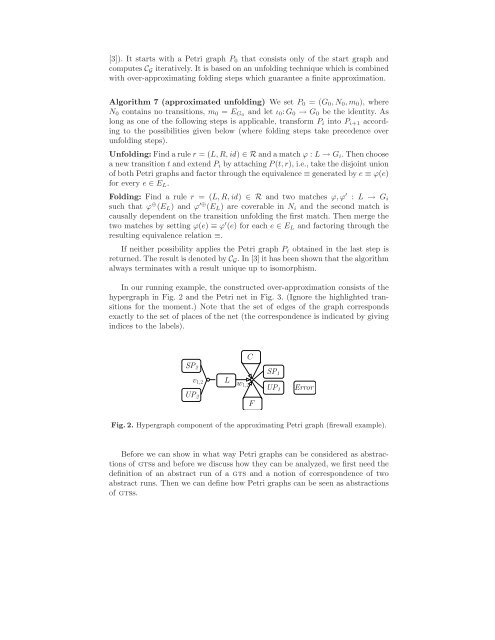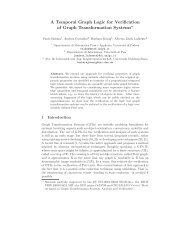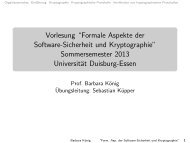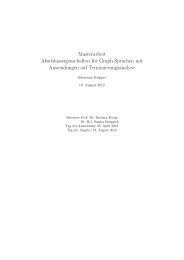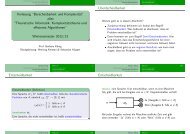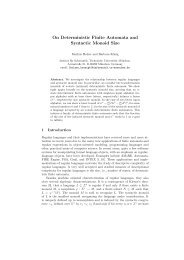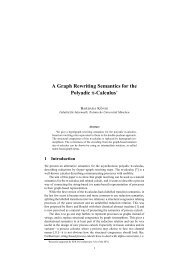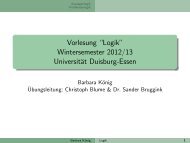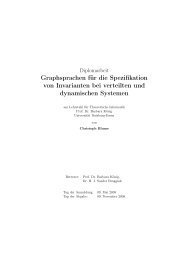Counterexample-guided Abstraction Refinement for the Analysis of ...
Counterexample-guided Abstraction Refinement for the Analysis of ...
Counterexample-guided Abstraction Refinement for the Analysis of ...
You also want an ePaper? Increase the reach of your titles
YUMPU automatically turns print PDFs into web optimized ePapers that Google loves.
[3]). It starts with a Petri graph P 0 that consists only <strong>of</strong> <strong>the</strong> start graph andcomputes C G iteratively. It is based on an unfolding technique which is combinedwith over-approximating folding steps which guarantee a finite approximation.Algorithm 7 (approximated unfolding) We set P 0 = (G 0 ,N 0 ,m 0 ), whereN 0 contains no transitions, m 0 = E G0 and let ι 0 :G 0 → G 0 be <strong>the</strong> identity. Aslong as one <strong>of</strong> <strong>the</strong> following steps is applicable, trans<strong>for</strong>m P i into P i+1 accordingto <strong>the</strong> possibilities given below (where folding steps take precedence overunfolding steps).Unfolding: Find a rule r = (L,R,id) ∈ R and a match ϕ : L → G i . Then choosea new transition t and extend P i by attaching P(t,r), i.e., take <strong>the</strong> disjoint union<strong>of</strong> both Petri graphs and factor through <strong>the</strong> equivalence ≡ generated by e ≡ ϕ(e)<strong>for</strong> every e ∈ E L .Folding: Find a rule r = (L,R,id) ∈ R and two matches ϕ,ϕ ′ : L → G isuch that ϕ ⊕ (E L ) and ϕ ′⊕ (E L ) are coverable in N i and <strong>the</strong> second match iscausally dependent on <strong>the</strong> transition unfolding <strong>the</strong> first match. Then merge <strong>the</strong>two matches by setting ϕ(e) ≡ ϕ ′ (e) <strong>for</strong> each e ∈ E L and factoring through <strong>the</strong>resulting equivalence relation ≡.If nei<strong>the</strong>r possibility applies <strong>the</strong> Petri graph P i obtained in <strong>the</strong> last step isreturned. The result is denoted by C G . In [3] it has been shown that <strong>the</strong> algorithmalways terminates with a result unique up to isomorphism.In our running example, <strong>the</strong> constructed over-approximation consists <strong>of</strong> <strong>the</strong>hypergraph in Fig. 2 and <strong>the</strong> Petri net in Fig. 3. (Ignore <strong>the</strong> highlighted transitions<strong>for</strong> <strong>the</strong> moment.) Note that <strong>the</strong> set <strong>of</strong> edges <strong>of</strong> <strong>the</strong> graph correspondsexactly to <strong>the</strong> set <strong>of</strong> places <strong>of</strong> <strong>the</strong> net (<strong>the</strong> correspondence is indicated by givingindices to <strong>the</strong> labels).CSP 2UP 2v 1,2 L w 1,2SP 1UP 1FErrorFig. 2. Hypergraph component <strong>of</strong> <strong>the</strong> approximating Petri graph (firewall example).Be<strong>for</strong>e we can show in what way Petri graphs can be considered as abstractions<strong>of</strong> gtss and be<strong>for</strong>e we discuss how <strong>the</strong>y can be analyzed, we first need <strong>the</strong>definition <strong>of</strong> an abstract run <strong>of</strong> a gts and a notion <strong>of</strong> correspondence <strong>of</strong> twoabstract runs. Then we can define how Petri graphs can be seen as abstractions<strong>of</strong> gtss.


